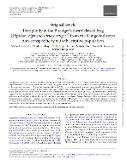Tetraploidy in the Boettger's dwarf clawed frog (Pipidae: Hymenochirus boettgeri) from the Congo indicates non-conspecificity with the captive population

Author
Zassi-Boulou, Ange-Ghislain
Publication date
2024Published in
Zoological Journal of the Linnean SocietyVolume / Issue
200 (4)ISBN / ISSN
ISSN: 0024-4082ISBN / ISSN
eISSN: 1096-3642Metadata
Show full item recordCollections
This publication has a published version with DOI 10.1093/zoolinnean/zlad119
Abstract
Cytogenetics can be used as a tool to study the evolution of polyploidy and taxonomy. Here we focus on aquatic African pipids, dwarf clawed frogs (Hymenochirus). Our study reveals that dwarf clawed frogs, present for decades in captivity, are best referred to as Hymenochirus sp. instead of the commonly used name 'H. boettgeri' or sometimes 'H. curtipes'. We present the first karyotype from a morphologically identified specimen of H. boettgeri with a known locality in the north-western Congo, which is tetraploid with 2n = 36. The captive Hymenochirus species has been found diploid in previous studies with different reported chromosome numbers; here we reveal 2n = 20A + 1B chromosomes. Our findings suggest that the tetraploid H. boettgeri karyotype evolved through fusion of two biarmed chromosomes and subsequent allotetraploidization, and is functionally diploid, similar to the origin of tetraploid clawed frogs in the subgenus Xenopus. We observed the stable presence of a single B chromosome in both sexes of our individuals from the captive population of Hymenochirus sp. However, additional investigation is necessary to clarify whether there is variation in the number of A and B chromosomes among populations, individuals, and/or tissues. Further research is also needed to understand the evolution and taxonomy of the genus Hymenochirus.
Keywords
amphibia, Anura, chromosome, cytogenetics, FISH, karyotype, polyploidy, taxonomy
Permanent link
https://hdl.handle.net/20.500.14178/2818License
Full text of this result is licensed under: Creative Commons Uveďte původ 4.0 International






